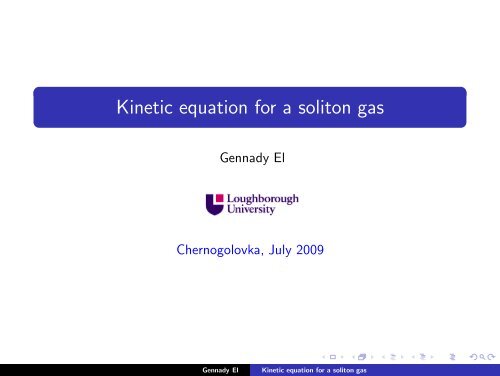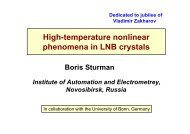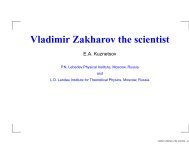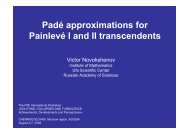Kinetic equation for a soliton gas - SOLITONS, COLLAPSES AND ...
Kinetic equation for a soliton gas - SOLITONS, COLLAPSES AND ...
Kinetic equation for a soliton gas - SOLITONS, COLLAPSES AND ...
You also want an ePaper? Increase the reach of your titles
YUMPU automatically turns print PDFs into web optimized ePapers that Google loves.
<strong>Kinetic</strong> <strong>equation</strong> <strong>for</strong> a <strong>soliton</strong> <strong>gas</strong>Gennady ElChernogolovka, July 2009Gennady El<strong>Kinetic</strong> <strong>equation</strong> <strong>for</strong> a <strong>soliton</strong> <strong>gas</strong>
MotivationDescription of “integrable turbulence”.V.E. Zakharov, Turbulence in integrable systems, Stud. Appl. Math.(2009)A particular important aspect: theory of <strong>soliton</strong> <strong>gas</strong>es.V.E. Zakharov, <strong>Kinetic</strong> <strong>equation</strong> <strong>for</strong> <strong>soliton</strong>s, JETP (1971)Here we consider only strongly integrable systems (like KdV, NLS etc.)Gennady El<strong>Kinetic</strong> <strong>equation</strong> <strong>for</strong> a <strong>soliton</strong> <strong>gas</strong>
From N-<strong>soliton</strong>s/N-gap potentials to a <strong>soliton</strong> <strong>gas</strong>N-<strong>soliton</strong>s: two approachesIST: reflectionless potentials (N-<strong>soliton</strong> solutions);Finite-gap theory: closing all spectral bands in the N-gap potentialleads to the N-<strong>soliton</strong>.Soliton <strong>gas</strong>: N → ∞; a generalised reflectionless potential (Marchenko)with shift invariant probability measure on it.IST:Gurevich, Zybin et. al. (2000, 2002): stochastic version of theLax-Levermore approach (KdV and defocusing NLS)Kotani (2008): KdV flow on generalized reflectionless potentials(Sato ’s Grassmanian approach)Finite-gap theory: El, Krylov, Molchanov and Venakides (1999):<strong>soliton</strong> <strong>gas</strong> as the thermodynamic limit of finite-gap potentials:N → ∞ , L → ∞ N/L ∼N∑k j = O(1)j=1Gennady El<strong>Kinetic</strong> <strong>equation</strong> <strong>for</strong> a <strong>soliton</strong> <strong>gas</strong>
From the Whitham <strong>equation</strong>s to kinetic <strong>equation</strong> <strong>for</strong><strong>soliton</strong>sAssuming the existence of the invariant spectral measurecharacterising spatially homogeneous <strong>soliton</strong> <strong>gas</strong>, we want todescribe slow evolution of this measure <strong>for</strong> an inhomogeneous<strong>gas</strong>, i.e. to derive kinetic <strong>equation</strong> <strong>for</strong> <strong>soliton</strong>s.Similarity with the <strong>for</strong>mulation of the Whitham modulation theory(but with the averaging over ensemble rather than period!).P.D. Lax (1991): The zero dispersion limit, a deterministic analogueof turbulence.Hence our interest in the thermodynamic limit of the Whitham<strong>equation</strong>s.Gennady El<strong>Kinetic</strong> <strong>equation</strong> <strong>for</strong> a <strong>soliton</strong> <strong>gas</strong>
Outline<strong>Kinetic</strong> <strong>equation</strong> <strong>for</strong> <strong>soliton</strong>s as the thermodynamic limit ofthe Whitham <strong>equation</strong>sGeneralised kinetic <strong>equation</strong>Hydrodynamic reductions and integrabilityConclusionsAlso, if time permits;Moments of the wave fieldFurther research directionsGennady El<strong>Kinetic</strong> <strong>equation</strong> <strong>for</strong> a <strong>soliton</strong> <strong>gas</strong>
The Whitham <strong>equation</strong>s (KdV case)The generating <strong>equation</strong> <strong>for</strong> the KdV-Whitham system is (Flaschka,Forest, McLaughlin 1979)(dp N ) t = (dq N ) x ,where dp N and dq N are the quasimomentum and quasienergydifferentials on the hyperelliptic Riemann surface of genus N:R 2 (λ) =∏(λ − λ j ), λ ∈ C, λ j ∈ R .2N+1j=1Asymptotic behaviour near λ = −∞:−λ ≫ 1 : dp N ∼ − dλ(−λ) 1/2 ,dq N ∼ (−λ) 1/2 dλGennady El<strong>Kinetic</strong> <strong>equation</strong> <strong>for</strong> a <strong>soliton</strong> <strong>gas</strong>
The Whitham <strong>equation</strong>sThe differentials dp N and dq N are uniquely defined by the normalisation:∮dp N (λ) = 0 ,β i∮dq N (λ) = 0 ,β ii = 1, . . .,N . j 1 2 j3 42 N 1gapband2 j 1The fundamental wavenumbers k j and frequencies ω j are found as∮∮k j (λ 1 , . . .,λ 2N+1 ) = dp N (λ), ω j (λ 1 , . . . , λ 2N+1 ) = dq N (λ),α j 2 jα jGennady El<strong>Kinetic</strong> <strong>equation</strong> <strong>for</strong> a <strong>soliton</strong> <strong>gas</strong>
Whitham <strong>equation</strong>s as the <strong>equation</strong>s <strong>for</strong> the spectralmeasureAssume that the finite-band part of the spectrum λ lies in [−1, 0].We integrate the Whitham system ∂ t dp N (λ) = ∂ x dq N (λ) on the real linefrom −1 to −η 2 ∈ [−1, 0] and take the real part:Here∂ t N N (−η 2 ) = ∂ x V N (−η 2 ).N N (λ) = 1 ∫λπ Re−1dp N (λ ′ )is the integrated density of states (Johnson & Moser 1982), andV N (λ) = 1 π Re ∫ λ dq N (λ ′ ) – its temporal analog.−1Importantly, dN N (−η 2 ) is a measure.Gennady El<strong>Kinetic</strong> <strong>equation</strong> <strong>for</strong> a <strong>soliton</strong> <strong>gas</strong>
Thermodynamic limitThe total density of statesρ N = 1 ∫0π Re−1dp N (λ ′ ) = 12πIn the thermodynamic limit limN→∞ ρ N = O(1).This is achieved by the following ( thermodynamic) spectral scalingN∑j=1k j|gap j | ∼1ϕ(η j )N|band j | ∼ exp {−γ(η j )N}, j = 1, . . .,Nwhere φ(η), γ(η) are some continuous positive functions on [0, 1].Venakides (1989) The continuum limit of theta functions;El, Krylov, Molchanov & Venakides (1999) Soliton turbulence as thethermodynamic limit od <strong>soliton</strong> latticesNote: |band j |/|gap j | → 0 as N → ∞ ∀j i.e. “infinite-<strong>soliton</strong>” limit.Gennady El<strong>Kinetic</strong> <strong>equation</strong> <strong>for</strong> a <strong>soliton</strong> <strong>gas</strong>
The thermodynamic limit of the Whitham <strong>equation</strong>sThe modulation system ∂ t N N (−η 2 ) = ∂ x V N (−η 2 )In the thermodynamic limit as N → ∞:dN N → πf (η)dη > 0 , dV N → −πf (η)s(η)dηs(η) and f (η) are related via:s(η) = −4η 2 + 1 η∫ 10lnη − µ∣η + µ ∣ f (µ)[s(η) − s(µ)]dµ, (1)Now, we postulate that on a larger scale, ∆x, ∆t ≫ 1:f (η) = f (η, x, t), s(η) = s(η, x, t)Then the modulation system trans<strong>for</strong>ms intof t = (fs) x , (2)Equations (2), (1) <strong>for</strong>m a closed system : the kinetic <strong>equation</strong> <strong>for</strong> theKdV <strong>soliton</strong> <strong>gas</strong> of finite density (El 2003)Gennady El<strong>Kinetic</strong> <strong>equation</strong> <strong>for</strong> a <strong>soliton</strong> <strong>gas</strong>
<strong>Kinetic</strong> <strong>equation</strong> <strong>for</strong> <strong>soliton</strong>s: small-density expansionWe replace s → −s. Now s is the velocity of <strong>soliton</strong> <strong>gas</strong>.s(η) = 4η 2 + 1 ηf T + (fs) X = 0 , (1)∫ ∞0lnη + µ∣η − µ ∣f (µ)[s(η) − s(µ)]dµ, (2)The small-density, ρ = ∫ ∞0fdη ≪ 1, expansion of (2), yieldss(η) = 4η 2 + 1 η∫ ∞0lnη + µ∣η − µ ∣ f (µ)[4η2 − 4µ 2 ]dµ + O(ρ 2 ), (3)– the velocity of a ‘trial’ <strong>soliton</strong> in a rarefied <strong>soliton</strong> <strong>gas</strong> (Zakharov 1971).So Eqs. (1), (2) represent a generalisation of Zakharov’s kinetic <strong>equation</strong><strong>for</strong> a rarefied <strong>soliton</strong> <strong>gas</strong> to the case of the <strong>gas</strong> of finite density.Gennady El<strong>Kinetic</strong> <strong>equation</strong> <strong>for</strong> a <strong>soliton</strong> <strong>gas</strong>
Generalised kinetic <strong>equation</strong>s <strong>for</strong> <strong>soliton</strong> <strong>gas</strong>es with elasticcollisions El & Kamchatnov (PRL 2005)Main ingredients: (i) the speed of a free <strong>soliton</strong> S(η) and (ii) thephase shift ∆x η,µ = G(η, µ) due to the <strong>soliton</strong>-<strong>soliton</strong> collision.Introduce the spectral distribution function f (η) ≡ f (η, x, t) and themean speed of a ‘trial’ η- <strong>soliton</strong> s(η) ≡ s(η, x, t)Then the self-consistent definition of the <strong>soliton</strong> velocity s(η) in adense <strong>soliton</strong> <strong>gas</strong> with the spectral distribution f (η) is given by theintegral <strong>equation</strong>s(η) = S(η) +∫ ∞0G(η, µ)[s(η) − s(µ)]f (µ)dµ ,Isospectrality implies the conservation <strong>equation</strong> <strong>for</strong> the spectraldistribution function f (η, x, t):f t + (sf ) x = 0 .Gennady El<strong>Kinetic</strong> <strong>equation</strong> <strong>for</strong> a <strong>soliton</strong> <strong>gas</strong>
Hydrodynamic reductions of the kinetic <strong>equation</strong>.f t +(sf ) x = 0 ,s(η, x, t) = S(η)+∫ ∞0G(η, µ)[s(η, x, t)−s(µ, x, t)]f (µ, x, t)dµWe introduce u(η, x, t) = ηf (η, x, t), v(η, x, t) = −s(η, x, t) andconsider N-component ‘cold-<strong>gas</strong>’ ansatzN∑u = u i (x, t)δ(η − η i ),i=1which reduces (1) to a system of N hydrodynamic conservation laws,∂ t u i = ∂ x (u i v i ), i = 1, . . .,N ,where the velocities v i = v(η i , x, t) and the ‘densities’ u i are related viaN∑v i = ξ i + ǫ ik u k (v k − v i ), ǫ ik = ǫ ki ,k=1ξ i = S(η i ), ǫ ik = 1η i η kG(η i , η k ) > 0 , v i = s(η i ).Gennady El<strong>Kinetic</strong> <strong>equation</strong> <strong>for</strong> a <strong>soliton</strong> <strong>gas</strong>(1)
Hydrodynamic reductions: N = 2For N = 2 the system of hydrodynamic laws assumes the <strong>for</strong>m∂ t u 1 = ∂ x (u 1 v 1 ), ∂ t u 2 = ∂ x (u 2 v 2 )u 1 = 1ǫ 12v 2 − ξ 2v 1 − v 2 , u2 = 1ǫ 12v 1 − ξ 1v 2 − v 1 .Passing to the Riemann invariants we obtainv 1 t = v 2 v 1 x , v 2 t = v 1 v 2 x . (1)The system (1) is linearly degenerate, i.e. its characteristic velocities donot depend on the corresponding Riemann invariants.What about N > 2?Gennady El<strong>Kinetic</strong> <strong>equation</strong> <strong>for</strong> a <strong>soliton</strong> <strong>gas</strong>
Hydrodynamic reductions: N ≥ 3.Theorem (El, Kamchatnov, Pavlov & Zykov 2008)N-component hydrodynamic type system∂ t u i = ∂ x (u i v i ), i = 1, . . .,N ,v i = ξ i +N∑ǫ ik u k (v k − v i ), ǫ ik = ǫ ki ,k=1where ξ 1 , ξ 2 , . . . , ξ N are constants and ǫ is a constant symmetric matrix,ǫ ik = ǫ ki , is:diagonalizablelinearly degenerate,semi-Hamiltonian (i.e. integrable - Tsarev 1985, 1991),<strong>for</strong> any N.The proof is based on the theory of integrable linearly degeneratehydrodynamic type systems developed by Pavlov (1987) and Ferapontov(1991).Gennady El<strong>Kinetic</strong> <strong>equation</strong> <strong>for</strong> a <strong>soliton</strong> <strong>gas</strong>
Linearly degenerate hydrodynamic type systemsDefinition. A diagonal hydrodynamic type system rt i = V i (r)rx i is calledlinearly degenerate if ∂ i V i = 0 ∀i. (∂ k ≡ ∂/∂r k )A semi-Hamiltonian (i.e. integrable) linearly degenerate hydrodynamictype system rt i = V i (r)rx i is characterised by the so-called Stäkel matrix⎛φ 1 1 (r1 ) ... φ 1 ⎞N (rN )... ... ...∆ =⎜ φ N−21 (r 1 ) φ N−2N(r N )⎟⎝ φ N−11 (r 1 ) φ N−1N(r N ) ⎠1 ... 1where φ i k (rk ) are certain functions, so that (Ferapontov 1991)where ∆ (k)iV i (r) = det∆(2) i,det∆ (1)iis the matrix ∆ without k-th row and i-th column.Gennady El<strong>Kinetic</strong> <strong>equation</strong> <strong>for</strong> a <strong>soliton</strong> <strong>gas</strong>
Linearly degenerate conservation lawsIt follows from Pavlov (1987) and Ferapontov (1991) that the system ofconservation lawsu i t = (ui v i ) x , v i = v i (u(r)) i = 1, . . .,Nis a semi-Hamiltonian linearly degenerate hydrodynamic type system iffthe densities u i and velocities v i (u) admit the representationsu i = det∆(1) idet ∆ (−1)i+1 P i (r i ),v i = det∆(2) idet∆ (1)iin terms of the Stäkel matrix ∆ via N functions r k ; here P i (r i ) arearbitrary functions.For the N - component hydrodynamic reductions of the kinetic<strong>equation</strong> it was proved in (El, Kamchatnov, Pavlov & Zykov 2008)that such a parametrization exists <strong>for</strong> any N.Hence: integrability of the ‘cold-<strong>gas</strong>’ hydrodynamic reductions <strong>for</strong> any N.Gennady El<strong>Kinetic</strong> <strong>equation</strong> <strong>for</strong> a <strong>soliton</strong> <strong>gas</strong>
N=3: explicit <strong>for</strong>mulae (El, Kamchatnov, Pavlov & Zykov, 2008).The three-component ‘cold-<strong>gas</strong>’ hydrodynamic reduction of the nonlocalkinetic <strong>equation</strong>∂ t u i = ∂ x (u i v i ), i = 1, 2, 3 ,v i = ξ i +3∑ǫ ik u k (v k − v i ) ǫ ik = ǫ ki .k=1has the Riemann invariant representationwhere∂ t r j = V j (r)∂ x r j , j = 1, 2, 3,V 1 = ζ 2r 2 − ζ 3 r 3r 2 − r 3 , V 2 = ζ 3r 3 − ζ 1 r 1r 3 − r 1 , V 3 = ζ 1r 1 − ζ 2 r 2r 1 − r 2ζ 1 = ξ 3ǫ 12 − ξ 2 ǫ 13ǫ 12 − ǫ 13, ζ 2 = ξ 1ǫ 23 − ξ 3 ǫ 12ǫ 23 − ǫ 12, ζ 3 = ξ 1ǫ 23 − ξ 2 ǫ 13ǫ 23 − ǫ 13Gennady El<strong>Kinetic</strong> <strong>equation</strong> <strong>for</strong> a <strong>soliton</strong> <strong>gas</strong>
N=3: explicit <strong>for</strong>mulae (El, Kamchatnov, Pavlov & Zykov, 2008).The Riemann invariants r 1 , r 2 , r 3 are expressed in terms of the densitiesu 1 , u 2 , u 3 asr 1 =r 2 =r 3 =(ǫ 12 − ǫ 13 )(ǫ 12 ǫ 13 u 1 + ǫ 12 ǫ 23 u 2 + ǫ 13 ǫ 23 u 3 + ǫ 23 )[(ξ 3 − ξ 1 )ǫ 12 + (ξ 1 − ξ 2 )ǫ 13 ]u 1 − (ξ 2 − ξ 3 )(ǫ 12 u 2 + ǫ 13 u 3 + 1) ,(ǫ 23 − ǫ 12 )(ǫ 12 ǫ 13 u 1 + ǫ 12 ǫ 23 u 2 + ǫ 13 ǫ 23 u 3 + ǫ 13 )[(ξ 1 − ξ 2 )ǫ 23 + (ξ 2 − ξ 3 )ǫ 12 ]u 2 − (ξ 3 − ξ 1 )(ǫ 12 u 1 + ǫ 23 u 3 + 1) ,(ǫ 13 − ǫ 23 )(ǫ 12 ǫ 13 u 1 + ǫ 12 ǫ 23 u 2 + ǫ 13 ǫ 23 u 3 + ǫ 12 )[(ξ 2 − ξ 3 )ǫ 13 + (ξ 3 − ξ 1 )ǫ 23 ]u 3 − (ξ 1 − ξ 2 )(ǫ 13 u 1 + ǫ 23 u 2 + 1) .Gennady El<strong>Kinetic</strong> <strong>equation</strong> <strong>for</strong> a <strong>soliton</strong> <strong>gas</strong>
ConclusionsThe thermodynamic limit of the Whitham <strong>equation</strong>s associated withhyperelliptic Riemann surfaces leads to the kinetic <strong>equation</strong>s <strong>for</strong> thecorresponding <strong>soliton</strong> <strong>gas</strong>es.The original Zakharov (1971) prescription <strong>for</strong> the determination ofthe velocity of a trial <strong>soliton</strong> in a rarefied <strong>soliton</strong> can be directlyextended to the case of the <strong>soliton</strong> <strong>gas</strong> of finite density.N-component cold <strong>gas</strong> hydrodynamic reductions of the generalizedkinetic <strong>equation</strong> <strong>for</strong> <strong>soliton</strong>s represent linearly degeneratesemi-Hamiltonian (integrable) systems of hydrodynamic type <strong>for</strong> anyN.Gennady El<strong>Kinetic</strong> <strong>equation</strong> <strong>for</strong> a <strong>soliton</strong> <strong>gas</strong>
References[1] El, G.A., Krylov A.L., Molchanov, S.A. and Venakides, S., ”Solitonturbulence as a thermodynamic limit of stochastic <strong>soliton</strong> lattices”,Advances in Nonlinear Mathematics and Science, PHYSICA D, 152/153,2001, pp 653-664.[2] El, G.A., ”The thermodynamic limit of the Whitham <strong>equation</strong>s”,PHYS LETT A, 311, 2003, pp 374-383.[3] El, G.A. and Kamchatnov, A.M., ”<strong>Kinetic</strong> <strong>equation</strong> <strong>for</strong> a dense<strong>soliton</strong> <strong>gas</strong>”, PHYS REV LETT 95, 2005, Art No 204101, 4 pp.[4] El, G.A., Kamchatnov, A.M., Pavlov, M.V., and Zykov, S.A.,”Nonlocal kinetic <strong>equation</strong>: integrable hydrodynamic reductions,symmetries and exact solutions” nlin. arXive 2008.Gennady El<strong>Kinetic</strong> <strong>equation</strong> <strong>for</strong> a <strong>soliton</strong> <strong>gas</strong>
Wave field moments in a <strong>soliton</strong> <strong>gas</strong>: the KdV caseWe have obtained that in the thermodynamic limit dN N → πf (η, x, t)dη.On the other hand, it is well known that the integrated density of statesN N (λ) is the generating function <strong>for</strong> the averaged Kruskal integrals I (N)k:N N (λ) = 2 √ −λ +I (N) 10 = limL→∞ L∫ L0∞∑k=0I (N)k(−2λ) k , −λ ≫ 1 ,u N (x)dx , I (N) 11 = limL→∞ L∫ L0u 2 N (x)dx , . . .Then the thermodynamic limit of Kruskal integrals is found as∫∞I (N)k→ 22k+22k + 1 (−1)k+1 η 2k+1 f (η)dη , k = 0, 1, 2, . . .0Gennady El<strong>Kinetic</strong> <strong>equation</strong> <strong>for</strong> a <strong>soliton</strong> <strong>gas</strong>
Wave field moments in a <strong>soliton</strong> <strong>gas</strong>: the KdV caseFor the two first moments we haveu(x, t) = 4∫ ∞Important restriction:0ηf (η, x, t)dη , u 2 (x, t) = 163∫ ∞0η 3 f (η, x, t)dησ = u 2 − u 2 ≥ 0 (1)For instance, <strong>for</strong> a one-component <strong>soliton</strong> <strong>gas</strong> f = f 0 (x, t)δ(η − η 0 ), sou = 4η 0 f 0 (x, t), u 2 = 163 η3 0 f 0(x, t).i.e. the varianceσ = 16f 0 η0( 2 η 03 − f 0).Now one can see that (1) imposes a restriction on the possible densityvalues f 0 <strong>for</strong> a one-component <strong>soliton</strong> <strong>gas</strong> with a given η 0 :Critical density <strong>for</strong> a <strong>soliton</strong> <strong>gas</strong>.f 0 < f cr = η 03 .Gennady El<strong>Kinetic</strong> <strong>equation</strong> <strong>for</strong> a <strong>soliton</strong> <strong>gas</strong>
Future researchConnection with hydrodynamic chains and 2+1 dispersionlesssystems.Motivation: The collisionless Boltzmann kinetic <strong>equation</strong> <strong>for</strong> thedistribution function f (p, x, t)∂f∂t + p ∂f (∫ ) ∂f ∂f∂x − ∂x dp ∂p = 0is equivalent to the Benney moment chain (Zakharov 1981, Gibbons1981)∂A n+ ∂A ∫n+1 ∂A 0+ nA n−1∂t ∂x ∂x = 0 , A n = p n fdpand to the dispersionless KP-II <strong>equation</strong> (Kupershmidt & Manin ??,Gibbons 1984, Kodama 1988)(u t + 6uu x ) x + u yy = 0 .Construction of physically relevant exact solutions.PDF, correlation function.Gennady El<strong>Kinetic</strong> <strong>equation</strong> <strong>for</strong> a <strong>soliton</strong> <strong>gas</strong>
Appendix 1. N=3: Exact solutions.1. Similarity solutionsThe family of the similarity solutions.r i = 1 ( x)t αli , i = 1, 2, 3,tis implicitly specified by the algebraic systemxt= c 1 ζ 1 (l 1 ) γ + c 2 ζ 2 (l 2 ) γ + c 3 ζ 3 (l 3 ) γ ,−1 = c 1 (l 1 ) γ + c 2 (l 2 ) γ + c 3 (l 3 ) γ ,0 = c 1 (l 1 ) γ−1 + c 2 (l 2 ) γ−1 + c 3 (l 3 ) γ−1 ,where γ = −1/α and c 1 , c 2 , c 3 are arbitrary constants.Gennady El<strong>Kinetic</strong> <strong>equation</strong> <strong>for</strong> a <strong>soliton</strong> <strong>gas</strong>
Appendix 1. N=3: Exact solutions.2. Quasi-periodic solutionsThe family of the quasi-periodic (3 periods) solution is implicitly specifiedby the system∫r 1x = ζ 1ξdξ√R7 (ξ) + ζ 2∫r 2ξdξ√R7 (ξ) + ζ 3∫r 3ξdξ√R7 (ξ) ,−t =0 =∫r 1∫r 1∫r 2ξdξ√R7 (ξ) +∫r 2dξ√R7 (ξ) +∫r 3ξdξ√R7 (ξ) +∫r 3dξ√R7 (ξ) +ξdξ√R7 (ξ) ,dξ√R7 (ξ) ,where7∏R 7 (ξ) = (ξ − E m ),m=1E 1 < E 2 < · · · < E 7 are arbitrary real constants.Gennady El <strong>Kinetic</strong> <strong>equation</strong> <strong>for</strong> a <strong>soliton</strong> <strong>gas</strong>
Appendix 2. <strong>Kinetic</strong> <strong>equation</strong> <strong>for</strong> the focusing NLS <strong>soliton</strong><strong>gas</strong>The focusing nonlinear Schrödinger (NLS) <strong>equation</strong> has the <strong>for</strong>miu t + u xx + 2|u| 2 u = 0Then the kinetic <strong>equation</strong> <strong>for</strong> a dense <strong>gas</strong> of bright NLS <strong>soliton</strong>s iss(α, γ) = −4α + 1 ∫ ∞2γ −∞Here∫ ∞0f T + (sf ) X = 0 ,lnλ − µ2∣λ − µ ∣ f (ξ, η)[s(α, γ) − s(ξ, η)]dξdη .f ≡ f (α, γ; X, T), s ≡ s(α, γ; X, T)λ = α + iγ ,µ = ξ + iηGennady El<strong>Kinetic</strong> <strong>equation</strong> <strong>for</strong> a <strong>soliton</strong> <strong>gas</strong>
Appendix 2. <strong>Kinetic</strong> <strong>equation</strong> <strong>for</strong> the focusing NLS <strong>soliton</strong><strong>gas</strong>N=2: collision of two cold <strong>soliton</strong> <strong>gas</strong>es.Let ρ 1 (x, t) = ρ 10 = constant 1 , ρ 2 (x, t) = ρ 10 = constant 2 .No continuous solution.Two hyperbolic conservation laws available:∂ρ 1∂t + ∂(s 1ρ 1 )= 0,∂x∂ρ 2∂t + ∂(s 2ρ 2 )= 0,∂xs 1 = s 1 (ρ 1 , ρ 2 ) s 2 = s 2 (ρ 1 , ρ 2 )Weak solution: three constant states separated by two strongdiscontibuities.ρ10ρ 1c+ρ2cρ1cρ2cρ20c - tc + txGennady El<strong>Kinetic</strong> <strong>equation</strong> <strong>for</strong> a <strong>soliton</strong> <strong>gas</strong>
A2. <strong>Kinetic</strong> <strong>equation</strong> <strong>for</strong> the focusing NLS <strong>soliton</strong> <strong>gas</strong>N=2: collision of two cold <strong>soliton</strong> <strong>gas</strong>es.Jump conditions:−c − [ρ 1c − ρ − 1 ] + [ρ 1cs 1c − ρ − 1 s− 1 ] = 0,−c − [ρ 2c − ρ − 2 ] + [ρ 2cs 2c − ρ − 2 s− 2 ] = 0,−c + [ρ 1c − ρ + 1 ] + [ρ 1cs 1c − ρ + 1 s+ 1 ] = 0,−c + [ρ 2c − ρ + 2 ] + [ρ 2cs 2c − ρ + 2 s+ 2 ] = 0.As a result, the densities and velocities of the components in theinteraction region areρ 1c = ρ 10(1 − κρ 20 )1 − κ 2 ρ 10 ρ 20, ρ 2c = ρ 20(1 − κρ 10 )1 − κ 2 ρ 10 ρ 20.s 1c = 4α 1 − κ(ρ 1c − ρ 2c )1 − κ(ρ 1c + ρ 2c ) , s 2c = −4α 1 + κ(ρ 1c − ρ 2c )1 − κ(ρ 1c + ρ 2c ) .The speeds of the ‘shocks’ :c − = −4α 1 + κρ 101 − κρ 10, c + = 4α 1 + κρ 201 − κρ 20.Gennady El<strong>Kinetic</strong> <strong>equation</strong> <strong>for</strong> a <strong>soliton</strong> <strong>gas</strong>






